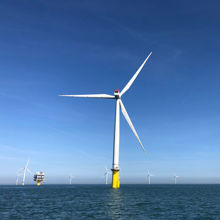Power shift: rising to the energy transition challenge
It is not enough to flick the switch to buy green energy if we are to achieve our goals. Finding solutions at the pace required demands energy efficiency and avoidance measures alongside the shift to renewable energy supplies.


Poya Rasekhi
Principal
Last updated: April 2022
Get in touch with our team
Global energy demand is insatiable, but with Earth’s climate in peril, we know the world must rapidly transition to renewables if we are to build a better future for generations to come.
As the race to meet United Nations decarbonisation goals speeds up, industry must take action with a clear plan that understands the complexities of energy and carbon supply chains.
As the International Energy Agency says in its global energy sector roadmap, the “gap between rhetoric and action needs to close if we have a fighting chance of reaching net zero by 2050 and limiting the rise in global temperatures to 1.5 °C.”
Working with public and private sector leaders across property, transport, energy and resource industries gives us a deep understanding of how to plan for this future. With a team of 16,000 designers, advisors and experts working across 140 countries, we are dedicated to building a sustainable future. We nurture deep partnerships with our clients to create a better world using imagination, technology and rigour.
In 2022, we are calling on Australian business leaders to deepen the discussion and put energy transition at the centre of their business transformation planning for the road ahead.
Through forums and discussion papers, we aim to create an environment for greater knowledge sharing across public and private sectors to find safe and resilient solutions to the climate challenge.
Every business must chart a unique course to achieve sustainability goals. For some, the energy transition is a path to powerful new business opportunities. For others, it is an inconvenience. Others still, an existential crisis.
Every organisation faces a unique confluence of change, risk and reward. Whatever the impacts, achieving great outcomes requires careful planning to account for all aspects of energy and carbon across all inputs and outputs – and how to transition most effectively.
Power generation is just part of the transition
It is not enough to flick the switch to buy green energy if we are to achieve our goals. Finding solutions at the pace required demands energy efficiency and avoidance measures alongside the shift to renewable energy supplies.
How will local solar and wind production be balanced against the need for a resilient power network? In which areas will hydrogen scale appropriately to efficiently feed energy into manufacturing or transport industries? We must rethink the entire energy system to ensure its viability in a transformed future.
Energy lives everywhere
Ambitious targets need a complete understanding of where energy inputs can be reduced and avoided. The future requires new ideas about how, where, and when we need energy in the built environment, from pumping water to pouring concrete.
Is the future of energy generation centralised with large producers transmitting power thousands of kilometers along transmission lines, or is a more distributed, urban energy system comprising micro-grids with renewable energy systems and storage devices more suitable to our future built environment?
Poya Rasekhi
Principal
Transforming assets
The energy transition will require the complete renewal of energy-intensive and energy-oriented sectors, with short and long-term planning needed to find new opportunities as fossil fuel assets are left behind.
In Australia, the end of coal-fired power stations and their reliable baseload power is accelerating. Our vision is for these sites to become the new engine rooms of the future – unlocking new clean energy and productivity opportunities for their owners, local communities and the Australian economy. Achieving this vision is no small feat.
We need visionary thinking, years ahead of closure. With the accelerated pace of change, this window of opportunity is closing fast. Our team is helping site owners through the initial planning stages, tackling uncertainty, and clarifying their purpose for businesses and communities.
Industrial transformation
The energy transition will require the complete renewal of energy-intensive and energy-oriented sectors, with short and long-term planning needed to find new opportunities as fossil fuel assets are left behind.
Transport industries, including rail, maritime, and aviation, face tremendous challenges during the transition, but leaders who find the right path will position their organisations for great success.
Can ports become hubs for green energy exports? How do we electrify transport systems to enable an end to fossil fuels in long-range freight and tourism? Supporting the needs of fuel-intensive industries must be a critical factor in any long-term solutions.
Sustainable cities
Cities are responsible for a large increasing percentage of the world’s energy consumption. So, how do we transform urban environments and drive energy sustainability to meet climate targets? We must revisit every aspect of how people, vehicles and energy networks flow through business districts, retrofit for lower energy demand, design for resilience, and use digital to accelerate the urban energy transition.
Whether we are working with the community, city governments, property developers, or any other organisation looking to thrive in the sustainable city landscape, we are helping to find paths to prosperity that respect the demands of a more energy-efficient future.





